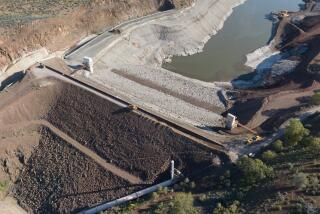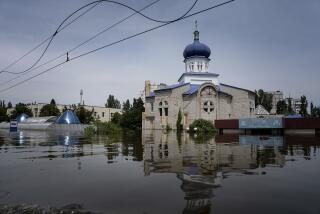Iraq’s Mosul dam remains volatile and unstable

- Share via
Reporting from the Mosul dam, Iraq — For more than a week, Nawar and Tayseer Adnan remained in their family home, avoiding the Islamic State militants who had seized their village, and secretly feeding intelligence to Kurdish Iraqi troops plotting a way to retake it.
When the offensive finally began, starting with a U.S. airstrike at the village’s edge, the brothers stayed in the bathroom for 24 hours until they heard Kurdish and Iraqi soldiers yell that it was safe to come out.
They were among the few civilians to witness the intense final hours of the battle for the Mosul dam, which Iraqi government forces — with a crucial assist from U.S. warplanes — retook from Islamic State militants on Monday after three days of fighting.
The U.S. military effort continued Thursday, with the Pentagon saying it had carried out six airstrikes against Islamic State vehicles and explosives near the dam, bringing the total U.S. airstrikes in Iraq over the last week to 90.
The Kurdish forces known as peshmerga are now back in control of the northern dam after an operation that could prove to be a launching pad for further joint U.S.-Iraqi action against the Islamic State.
However, in a sign that the area remained volatile, Kurdish Iraqi soldiers on Thursday ordered the Adnan brothers and the few dozen other young men who had remained behind to evacuate their village, a sprawling warren of wood-frame houses below the dam’s hulking power station.
“We are happy to be out,” said Nawar Adnan, 24, standing outside a Kurdish checkpoint at dusk with a box of clothes. “It was a scary few days.”
U.S. military advisors met with Kurdish Iraqi commanders near the dam Thursday to discuss next steps, said Gen. Mansour Barzani, commander of the peshmerga special forces who led the ground assault against the militants.
U.S. and Iraqi forces have described the three-day operation at the dam as a success. A tour of the area showed the result of U.S. airstrikes: craters in the flat, rocky earth where militants had been dug in, the twisted wreckage of vehicles, concrete bunkers blown into chunks.
Barzani’s men cleared more than 250 bombs planted by the militants to slow the army’s advance, and peshmerga explosives teams were still combing the massive area surrounding the dam, which includes a 40-mile-long lake along the Tigris River.
Barzani urged the United States and international allies to send more assistance to his forces.
“We need help. It’s not just our war against ISIS,” he said in an interview at the dam’s power station, using an acronym for the Islamic State. “This is the world’s war.”
The once vaunted peshmerga, the leading military force in Iraq’s semiautonomous northern Kurdish region, were sharply criticized for melting away as the militants advanced this month. Now riding high again, Barzani greeted a parade of reporters at the dam as his soldiers, wearing sunglasses against the blinding summer sun, snapped selfies above the emerald-colored reservoir and one aging officer chomped on a cigar.
But commanders acknowledged that they had received help from Iraqi army special forces based in Baghdad. Members of Iraq’s Golden Brigade joined one of four peshmerga columns that began advancing on the dam Sunday, an unusual instance of a joint ground operation by the two forces.
Two peshmerga and three Iraqi special forces soldiers were killed in the fighting, along with an unknown number of militants. Barzani said he found the bodies of at least 10 militants.
But there was no apparent damage to the dam itself, the country’s largest and the source of power and water for much of northern Iraq. Engineers on Thursday made their first visit to the site since the fighting began and were still conducting assessments, but residents in the area said there had been no interruption in the power supply.
The dam has a controversial past. It was built in the 1980s on the order of Saddam Hussein despite warnings from its German and Italian engineers that the earth underneath — an unstable mix of gypsum, chalky limestone, clay and fractured limestone — was too unsteady to support such a mammoth piece of infrastructure.
Hussein demanded it be built anyway, and since its inception technicians have had to pump grout and concrete slurry into the foundation on a near-daily basis to fill countless little cracks that are constantly forming under the surface.
Engineers familiar with the project said that if the foundation wasn’t attended to during the nearly two weeks the dam was under ISIS control, the structure could be seriously undermined. A breach of the dam — the worst-case scenario that U.S. officials feared when launching airstrikes to dislodge the extremists — could cause massive flooding and wipe out Mosul, a city of 1.5 million people about 30 miles downstream.
“The dam is unstable and it’s become more unstable over time,” said John H. Hollis IV, a security adviser who traveled to the dam with U.S. and Iraqi officials from 2004 to 2006 to conduct stabilization operations. “Anytime there’s a stop in the process [of shoring up the foundation], the risks go up, absolutely.”
Islamic State commanders clearly saw the importance of the site. The Adnan family’s village — known in Kurdish simply as “Dam” — was seized by 50 to 60 fighters, but hundreds of militants soon were roaming the area, a diverse group whom the brothers said included men from Iraq, Lebanon, Saudi Arabia and European countries.
The extremists stole the family car and made off with cash and electronics from their home. Some residents were taken prisoner, they said, although most were allowed to leave before the clashes began.
Yet the power never went out, allowing them to keep their cellphones charged and make clandestine calls to a family friend with the peshmerga, they said. The soldiers didn’t approach the village until after the U.S. bombing began Sunday afternoon.
A string of villages leading toward the dam still lay abandoned Thursday, some apparently in haste, with laundry fluttering from balconies. The residents there are a mix of Sunni Muslim Arabs, Kurds, Christians and others. Barzani said that some villages, particularly those with Sunni Arabs, included Islamic State sympathizers who fired on peshmerga forces as they advanced.
“If it were up to me,” Barzani said, “the people who helped ISIS won’t ever come back here.”
Follow @sbengali on Twitter
More to Read
Sign up for Essential California
The most important California stories and recommendations in your inbox every morning.
You may occasionally receive promotional content from the Los Angeles Times.











